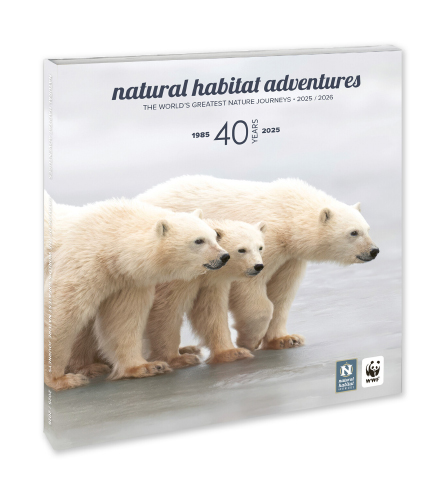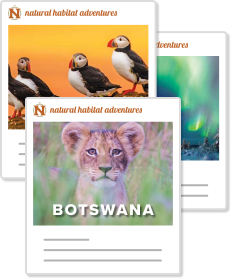For millennia, the snow leopard has roamed Asian mountain ranges teeming with sheep, ibex, marmots, pikas and hares. Their thick white-gray coats are spotted with large black rosettes blending into steep, stark, high Asian mountains.
Though their habitat ranges over 770,000 square miles across 12 countries, snow leopards are known as gray ghosts due to their remote high-altitude habitat, unique natural camouflage, elusive nature and sparse distribution.
They have been considered virtually unseeable, but that is changing as conservation becomes a priority across their historic range.
Conservation Creates Opportunity to Spot Snow Leopards
In northern India, conservation organizations like World Wildlife Fund (WWF) work with local villagers to protect these cats, so sightings—and photo opportunities—are increasing. This is the area Nat Hab visits on its Land of the Snow Leopard itineraries.
In the land of the snow leopard, there are many stories to tell, from the history of the rugged, high-altitude passes to the local flora, fauna, and people of many cultures playing out in the Ladakh region today.
Here are six types of iconic images to capture on your photographic journey into the land of the snow leopard:

Photographer Ralph Lee Hopkins, Grand Himalaya Range, Ladakh, India
1. Spot Snow Leopards in Hemis National Park
The most coveted image to capture is of the snow leopard itself, roaming free in its natural habitat. But how do you find them?
An individual snow leopard’s home range can vary from 5 to 195 square miles, and population density can range from <0.1 to 10 or more individuals per 38.6 square miles, depending on prey densities and habitat quality.
As of January 2024, India’s first comprehensive scientific survey estimated the snow leopard population at 718 individuals.
The rugged cliffs and vast, snow-covered expanses of Hemis National Park, one of the largest national parks in India, boast one of the highest densities of snow leopards in any protected area in the world.
For your first iconic shot, aim to capture a snow leopard in its natural habitat, resting on a rocky ledge, for example, or stalking prey across the snow. Their camouflage against the rugged mountain landscape makes them a challenge to spot, but the resulting photograph is incredibly rewarding.

© Nat Hab Expedition Leader Surya Ramachandran
Basic tips for photographing snow leopards:
- Use a telephoto lens to focus on the snow leopard’s distinctive fur patterns and piercing eyes, or opt for a wide shot to capture the vastness of the landscape and the isolation of this solitary predator.
- Try capturing wide-angle shots to show the vastness of their surroundings, as well as closer portraits that highlight the snow leopard’s distinctive fur patterns, piercing eyes, and muscular frame.
- The best time to spot snow leopards is November through April when the snow is at its deepest, and they descend to the valley following their prey. Snow leopards are most active during dawn and dusk; take advantage of the golden light to create a dramatic atmosphere.

2. High Altitude Landscapes
The land of the snow leopard can be stark, rugged, and majestic. Winding canyons, frozen rivers, rocky outcrops, and alpine meadows provide ideal habitat for snow leopards and their prey—and your landscape photography!
The Himalayan mountains are a photographer’s paradise. Rocky peaks, often dusted in snow and bathed in crisp mountain light, provide a stunning backdrop for wildlife photography, as well as breathtaking standalone landscape shots.

Photographing these towering giants during the golden hours—sunrise and sunset—can produce some of your most memorable shots.
- Play with light & timing: The warm hues of dawn and dusk contrast beautifully against the cool blues and whites of the mountains, creating a striking visual. So, too, though, do washed-out mid-day color shots that look black and white.
- Use a wide-angle lens to capture sweeping panoramas and incorporate layers into your composition, such as foreground details like prayer flags, rock formations, or wildlife, to give depth to your images. Incorporate frozen rivers as leading lines that draw the viewer’s eye into the scene.
- Use long exposures to create a smooth, glassy effect on the frozen landscape, while the surrounding jagged peaks remain sharply in focus, providing a dynamic contrast between stillness and texture.

3. High-Altitude Wildlife: Photograph Himalayan Ibex, Blue Sheep and Wolves
In this fascinating, fragile ecosystem, the snow leopard shares its habitat with:
- Tibetan Wolf: This high-altitude wolf is a rare sight, adapted to the harsh mountain environment and known to roam remote areas in search of prey, such as blue sheep and smaller mammals.
- Wild Dog (Dhole): Known for their reddish-brown fur and social behavior, endangered wild dogs are skilled hunters that work in packs to take down prey larger than themselves.
- Blue Sheep (Bharal): A nimble herbivore with a bluish-gray coat that blends into rocky landscapes, blue sheep are a primary prey species for snow leopards and are often seen navigating steep cliffs.

Blue sheep
- Urial: This wild sheep, with its distinctive curved horns, is native to the mountainous regions of Ladakh and is commonly spotted grazing on grassy slopes.
- Red Fox: Known for its thick coat and bushy tail, the red fox is a resourceful predator, preying on small mammals and birds while easily adapting to the cold climate.

Red fox © Nat Hab Expedition Leader Surya Ramachandran
- Eurasian Brown Bear: Found at lower elevations during warmer months, this large bear hibernates through winter and forages for roots, berries, and small animals in the summer.
- Asiatic Ibex: With its long, curved horns, the Asiatic ibex is a hardy climber, often found in rugged areas where it grazes on grasses and shrubs.
- Himalayan Marmots: These large, burrowing rodents are commonly seen in alpine meadows, where they forage for vegetation and hibernate through the long, cold winters.
Each of these species plays a unique role in Hemis National Park’s ecosystem. Scan mountain ridges for animal sightings and your next iconic photographs.
Wide shots that emphasize the dramatic terrain will lend a sense of scale and grandeur to your photos.

Ibex © Nat Hab Expedition Leader Surya Ramachandran
Use a fast shutter speed to freeze action shots of animals leaping across the mountainside or engaging in natural behaviors like foraging and climbing.
Learn more from our Himalayas Wildlife Guide.
4. Cultural Encounters: Photographing Ladakh’s Traditional Villages
The Ladakh village of Leh, an ancient Silk Road trading hub and a center of Tibetan Buddhism, is 600 miles from Delhi but feels a world away. Photograph poplar trees and prayer wheels, plus ancient monasteries over the Indus River.

Nat Hab Guest sharing photos in Mangyu Village, Ladakh, India © Ralph Lee Hopkins
For centuries, Leh was a crossroads for Indus Valley trade between Tibet, Kashmir, India and China—routes that carried salt, cashmere wool, indigo and silk. Local people are ethnic Tibetans who speak Ladakhi, and Buddhism and Islam have co-existed peacefully here since the 8th century.
Leh sits at 11,482 feet in elevation—visitors ready to climb the many steps of the terraced 15th-century Thiksay Monastery may be rewarded with ancient ceremonies performed the same ways for thousands of years.

Monks at Sunrise, Thiksy Tibetan Buddhist Monastery, Ladakh © Ralph Lee Hopkins
For your fourth iconic shot, focus on cultural details. Capture fluttering prayer flags, sun-drenched mud-brick homes, and the ancient Buddhist stupas that dot the landscape. Capture close-up images of an elder’s weathered face or a monk spinning prayer wheels at a local monastery.
Use portrait techniques to highlight the warmth and hospitality of the villagers, or zoom out for environmental portraits that show the scale of villages set against the Himalayan backdrop. Document details like intricately painted monasteries, prayer flags fluttering in the wind, and beautiful traditional homes built from local materials.
While the snow leopard is the star of this expedition, the culture of Ladakh provides another layer of photographic richness.
Tips for Photographing people and culture:
- Adjust for High Contrast Lighting: At high altitudes, light is intense, often creating harsh shadows.
- Use exposure compensation (-1 or -2 stops) to avoid overexposure or shoot during golden hours when light is softer. A reflector can also help fill in shadows on faces.
- Use a Wide Aperture (f/2.8 – f/5.6): A wider aperture isolates your subject from the background, creating a beautiful bokeh effect. This is ideal for focusing attention on individuals in busy cultural scenes or emphasizing fine details in traditional attire.
- Always ask permission and respect local cultural preferences.

Leh Tsemo Fort, Ladakh
5. Over 400 avian species have been spotted around Leh, India
According to eBird, over 430 bird species have been recorded in the Leh area, including:
- Golden Eagle: A majestic raptor known for its impressive wingspan and hunting prowess.
- Bearded Vulture: Also known as the lammergeier, this large bird, with a 10-foot wingspan, is distinguished by its unique feeding habits and striking appearance.
- Himalayan Snowcock: A high-altitude game bird adapted to the rugged terrains of the Himalayas.

Himalayan Snowcock
- Red-billed Chough: Recognizable by its glossy black plumage and bright red bill, it is often seen performing acrobatic flights.
- Horned Lark: A small passerine bird known for the distinctive black “horns” on its head.
Your fifth iconic shot could capture a golden eagle or bearded vulture in flight against the stunning backdrop of the Himalayas.
For a more serene image, focus on the contrast between a still bird’s wings and the snow-dusted peaks. A wide-angle shot can capture the scale of the birds in relation to the vast, open skies of the Himalayas.

Bearded Vulture
Tips for Photographing Birds of Prey:
- Telephoto Lens and Fast Shutter Speed: A telephoto lens (400mm or longer) with a fast shutter speed allows you to capture the raptors in mid-flight with clarity. Are you shooting small, quick birds in low light? Can you reduce your shutter speed, or would it be better to shoot at a higher ISO?
- Background and Scale: Frame birds against the snowy peaks or open skies to emphasize their impressive size and the vastness of their surroundings. What’s the story you’re telling?
- Golden Eagles and Bearded Vultures in Action: Seek out soaring; when these birds dive, glide on thermals, or interact with the landscape, focus on their wide wingspans and flight patterns for powerful, dramatic shots.
For a standard bird-in-flight shot, set:
- fast shutter speed of 1/2000-1/4000 seconds (depending on bird size),
- wide-open aperture (like f/4 on a 600mm lens),
- auto ISO.
- Use back-button focus,
- keep vibration reduction or image stabilization
- set the lens focus limiter to speed up autofocus.

Golden Eagle
For focus settings, you may want to use Auto AF, Wide Area AF, or 3D continuous autofocus, choosing the smallest focus area you can reliably keep on the bird’s head.
- Still portraiture versus birds in flight: You’ll need to use different settings for bird photography, depending on whether you’re taking portraits or birds in flight. Portraiture settings differ based on circumstance, but you might start wide open (f/5.6) at 1/1000 of a second with Auto ISO.
- A note on exposure compensation: If you spot a backlit bird and dial in a stop or two of positive exposure compensation, a shot at ISO 1600 might be acceptably free of noise, but at 3200 or 6400? That will depend upon your camera and its sensor. As a general rule, a noisy shot is better than a blurred one.
6. Challenges Facing the Snow Leopard
Despite their adaptation to extreme environments, snow leopards face an array of threats, from poaching to climate change.
Conservation efforts are vital to ensure the survival of these big cats, and photographs can tell this story to inspire awareness and advocacy.
Key challenges facing snow leopards include:
- Poaching and Illegal Trade: Snow leopards are hunted for their coats and bones, which are used in traditional medicine. They are illegally traded across Asia.
- Human-Wildlife Conflict: As their prey populations decrease, snow leopards often prey on livestock, leading to retaliation from local herders.
- Habitat Loss: Infrastructure projects like roads and mining disrupt snow leopard habitats, fragmenting the areas where they hunt and breed.
- Climate Change: Warming temperatures are shifting the treeline upward, which may force snow leopards to higher altitudes where prey is scarcer.

Snow Leopard walking along the Indus bank grasses of the Ramganga river © Nat Hab Expedition Leader Surya Ramachandran
Tips for Capturing Snow Leopard Conservation Stories:
- Document Human and Wildlife Interactions: Photograph herders, livestock, and snow leopards in shared spaces to capture the complexity of human-wildlife relationships.
- Impactful Storytelling: Use close-up shots of damaged habitats or signs of encroachment to illustrate the challenges facing these animals. Capturing conservationists at work can also tell a story of hope and effort.
- Raising Awareness: By documenting these threats, your photos can shed light on the urgent need for conservation, engaging others in the fight to protect snow leopards and their fragile ecosystem.
On Nat Hab’s Snow Leopard Quest Photo Expedition you can take advantage of in-depth photography experience, spending seven nights at a private mountain lodge in snow leopard territory adjacent to Hemis National Park, with the region’s most experienced naturalist guides and expert photographers.
Share the Story of the Snow Leopard
Snow leopards are a vulnerable species; their range continues to decline as a result of human settlement, while a warming climate could diminish up to 30% of their terrain in the Himalayas.
From the snow leopards of Hemis National Park to the high-altitude landscapes, wildlife, and culture of Ladakh, these six iconic shots will enrich your photography portfolio and tell the story of your journey through the land of the snow leopard. What story will you share?
To learn more, explore WWF’s resources on snow leopard conservation and wildlife protection in the Eastern Himalayas.




























